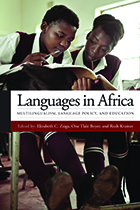|
Reviewed by Dr. Karen Ferreira-Meyers, University of Swaziland, Institute of Distance Education, Senior Research Associate, University of Johannesburg All chapters look at language issues in Africa, from specific focus on individual countries, to comparative studies involving two countries, and general discussions on reading competency, multilingualism, mother-tongue-based education, (metaphoric) language use in politics, advertising, and media. As stated in the introduction, the volume was produced following an Annual Conference on African Linguistics in Africa held in March 2013, and a concurrent workshop on language and education in Africa. At the onset was the observation that African communities are inherently multilingual, as they use their mother tongues, national or vehicular, and international languages, all organized in concentric circles. Three negative observations are made about this: 1. Some languages are dying, 2. Many are devalued (even healthy ones) and 3. “Schools are failing” (p.4-7). Luckily, there is also good news, including the wish and will of communities to preserve their culture and language, the fact that community-based education programs show clear success rates, that language policies can change, that linguistic knowledge contributes in these transformations, that multilingualism is a strong basis for creativity, which can lead to preservation of culture and revitalization of language (p.7-11). The 14 chapters all contribute in answering a number of urgent and important questions, namely what happens when an individual’s home language is different from the larger national or even wider international language? How do language policies impact on education? In which ways does culture preservation influence language survival and revitalization? The importance of research is highlighted in Trudell and Adger’s chapter “Early Reading Success in Africa: The Language Factor.” In their conclusion, they rightly state “assumptions made about language and reading have not been tested in African language contexts.” Improved professional collaboration between linguists and educators is one of their recommendations. Bokamba’s contribution “Multilingualism as a Sociolinguistic Phenomenon: Evidence from Africa” offers a broad overview of existing, although limited in scope, research on individual and societal multilingualism and promotes intensified research on language planning and acquisition. Poor school language proficiency is at the basis of low classroom interaction which in turn leads to negative learning outcomes. This is what Kiramba concludes based on her observations in selected Kenyan primary schools. Walter continues the discussion by investigating and comparing teacher effects in mother-tongue-based multilingual education programs in Cameroon and the Philippines. Arkorful’s “Ghana’s Complementary Education Program,” looks at the functional relevance of the curriculum topics, language of instruction and the facilitators’ mastery over the content knowledge as factors influencing knowledge construction. The importance of attitude towards language is highlighted in Beyogle’s article comparing Dagara speakers’ vision on language and education in communities along the Burkina Faso-Ghana borders. Issues of minority languages are discussed by O. Boyer and E. Zsiga, in particular the case of Sebirwa in Botswana. The authors note the link between language policy, literacy materials, and indigenous language preservation. Seid’s analysis of one of Ethiopia’s minority languages, Nao, lacks in precision and is repetitive. Nevertheless, his conclusion on language shift and possible provision of social services in the community’s is noteworthy. Sha notes that the South African Gujarati community increasingly views language as unimportant in defining its ethnic identity. Rather, Gujaratis see culture and religion as means to maintain their culture. Proverbs, urban popular music, advertisements, metaphors in political discourse and filmic visualizations of attitudes to language are all different ways of looking at language use and linguistic diversity. The authors of the articles on these topics have in common that they want to underscore how “languages and linguistic strategies employed in the different spheres of popular culture […] indicate how people relate to issues in the wider social landscape” (p. 134). Each article/chapter has a reference section at its end. The finely edited volume, completed by a contributors’ page and an index, allows readers from different backgrounds, whether specialists or novice linguists or mere interested parties, to receive current information on languages in Africa. |


 Languages in Africa – Multilingualism, Language Policy, and Education
Languages in Africa – Multilingualism, Language Policy, and Education